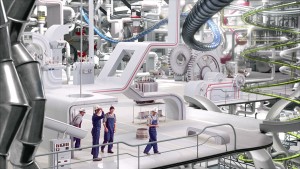A magical computer factory complete with singing workers, robots and moving parts was the creation of The Mill NY for ‘Treats,’ a Traktor-directed spot featuring Dell’s colourful range of Inspiron laptops. The Mill NY’s 3D supervisor Andrew Proctor takes fxguide through the work.
fxg: What was The Mill NY’s brief for this spot?
Proctor: The production company had designed all the backgrounds and had also gone and shot everything. They ended up with a lot more greenscreen than we initially had thought. So our role became designing what the factory had to look like.
I think we had seven days from getting an edit to delivering the spot. There are about 15 or 16 shots, all of which have totally replaced backgrounds with foreground CG objects and particle effects in there as well. We had about six or seven people working on the effects.
fxg: Can you talk about the design work that was involved?
Proctor: There were some sketches done by the directors, Traktor. They wanted the factory to be whacky, fun and colourful. Initially we thought we’d be doing matte painting extensions to a set that they built. Then we realised we were going to have to do so many matte paintings that we should really just build all the 3D geometry instead. This meant we could track the shots and re-use imagery between shots.
In terms of designs, it was a case of looking for ideas on the internet and other places. We had to find a balance between it looking fairly real or believable and also slightly whacky. We designed lots of little props and had a library of them that we could re-use in different shots – cogs, wheels, skinny tubes et cetera. Normally we’d get a paper concept approved but here we just didn’t have time so we launched straight modelling in 3D.
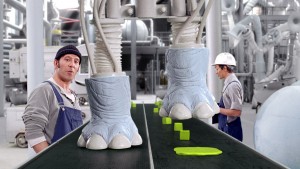 fxg: What tools did you use for modelling and animating?
fxg: What tools did you use for modelling and animating?
Proctor: We used Autodesk Softimage with a little bit of Maya in there. We have an in-house exporter that can be used if someone wanted to model in Maya. It was all put together in Softimage and then lit and rendered in mental ray. Most of the scenes were lit with the Final Gather and Architectural mental ray shaders.
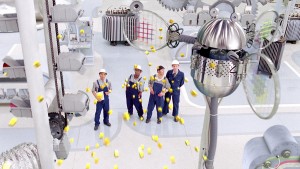 fxg: Let’s talk about some of the individual shots. How did you create the squirting devices?
fxg: Let’s talk about some of the individual shots. How did you create the squirting devices?
Proctor: Firstly, we had to replace all the backgrounds in those shots, except for the people. The squirters were filmed as a prop on set, but they found they couldn’t quite get the timing right. One of the things about this spot is the singing going on in the factory. They wanted the squirty props to be perfectly timed to the music. They tried playing with the edit to re-position and re-time the devices, but it looked a bit 2D and cut-out and the perspective wasn’t changing correctly.
So we decided to just re-build props in CG. We swapped them out and of course the client didn’t realise at the start that they were totally replaced. It helped with that shot having the real props there as reference so we could match our CG versions to replicate the highlights and the colours and tones. That gave us total control for the timing and also what they squirted out.
The goop that comes out was also all CG. We experimented with some particles at first, but then realised that conforming some cylinder geometry with lots of nice displacements and texture maps worked well. It was also much more controllable. We rendered it with sub-surface scattering to give it that gooey, translucent look. The conveyor belt that carries the goop is also another CG element. It was actually shot for real, but again we realised the timing had to match the squirters, so we re-built it.
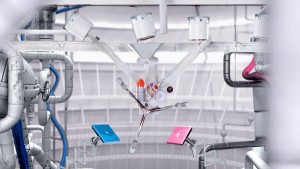 fxg:Did you use particles for the cubes being hit by the tennis racquet devices?
fxg:Did you use particles for the cubes being hit by the tennis racquet devices?
Proctor: Yes, that was done in Softimage ICE, which was fun to use. It gives you quite a bit of freedom to change workflows if need be. The tree structure in ICE lets you change things really quickly. So the client could say, ‘Oh we don’t want that to be green, we want it to be red,’ and we could do it. The shots of the cubes bouncing through tubes is all CG, along with a totally synthetic background. Pretty much all we were left with was the people.
For the shots of the cubes being squashed out and put up into shapes, we were trying to come up with clever ways of doing that by using, say, rigid-body or cloth dynamics. In the end we used traditional shape animation and blend shapes with lattices and deformations which became much more controllable.
fxg: How did you create the dancing robot? It looks like there was a puppeteered version on set.
Proctor: Again, for those shots we replaced the background and the conveyor belt and then tracked the motion of the actual robot props. Then we used that to slice geometry. We actually did a little cheat where the geometry was pre-sliced and then we put some bones and chains in to curl it up and put it away and animate it. It was another shot where we were scratching our heads to come up with a clever way to achieve the shot in the time we had, but it actually gave a much better result than the usual way we’d do it.
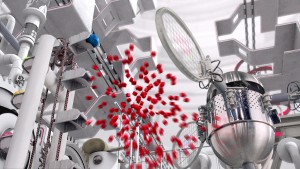 fxg: Were there any particular compositing challenges for the spot?
fxg: Were there any particular compositing challenges for the spot?
Proctor: Probably the multiple layers of CG was the biggest issue. Most of the CG that we do gets composited by the lighters and renderers in the CG department in Shake or Nuke before it goes into the Flame suite for marrying with the live action and finishing. So a lot of the render passes we produce are controlled by the render artist. What we give to the Flame artist is a final beauty composite for a background to blend together, rather than giving say 25 passes of CG. Another thing we did in compositing was using the depth of field tools in Nuke to make depth passes and Z blurs for the factory shots, just to give it a denser feel.
fxg: How would you sum up the work for ‘Treats’?
Proctor: I think we were able to finish the spot in such a tight turnaround by relying on tried and tested methods. At the same time, we had a lot of creative issues to address. For example, we had to think about the colour palette. The computers are very bright, so we accented the background with similar kinds of tones and colouring. It was definitely a lot of fun to come up with ideas for how things should look in the factory, and then make this happen in just seven days!
CREDITS
Agency: Mother NY
Creatives: Mat Driscoll, Greg Hunter
Producer: Emma Starzacher
Production Company: Traktor
Director: Traktor
DP: Tim Maurice Jones
Producer: Rani Melendez
Editing Company: Bikini
Editor: Avi Oron
Post Production: The Mill NY
Producer: Bethan Thomas
Telecine: Fergus McCall
Lead Flame: Alex Lovejoy
Flame: Des Anwar, Randy McEntee, Gavin Wellsman
3D Supervisor: Andrew Proctor
3D: Ruben Vanderbroek, Vince Baertsoen, Kevin Ives, Mike Panov, Yorie Kumalasari, Nao Minami

